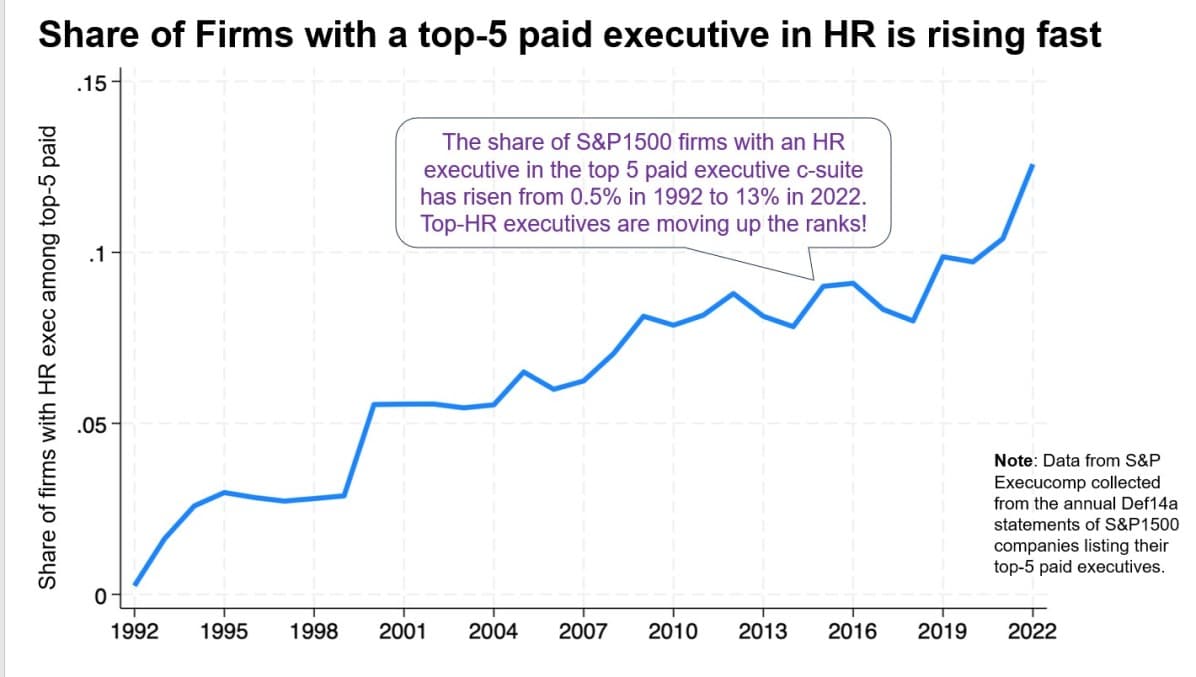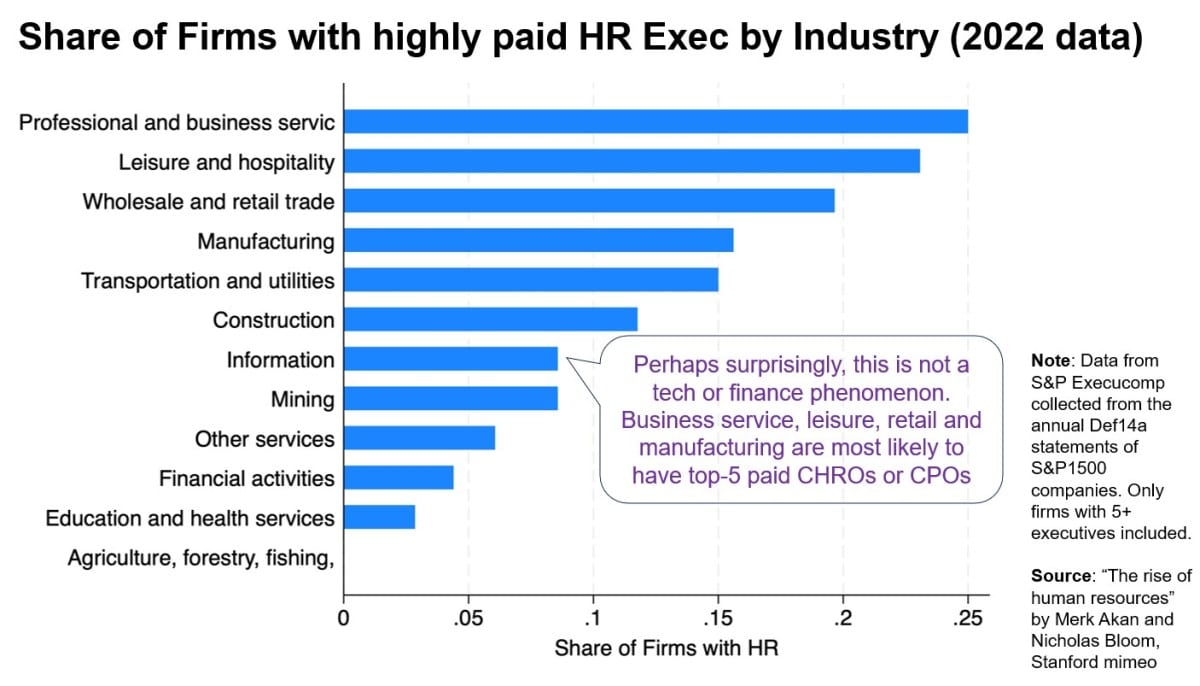Over the past 30 years, HR has transformed from a largely administrative function to a highly strategic one, accelerated as HR managed the people impact of the pandemic and the evolution into the new world of work, experts say. This building influence with the C-suite is seen in the growth of HR leaders’ multi-million-dollar compensation packages and a move toward C-level titles.
HR leaders, for example, are increasingly among their organizations’ highest-paid executives, based on salaries, bonuses, stock options and stock grants. The share of companies in the S&P 1500 whose HR leaders are among the top-five highest-compensated execs has risen from half a percent in 1992 to 13% in 2022, according to a recently released report, The Rise of Human Resources, by Stanford University professor Nick Bloom and pre-doctoral research fellow Mert Akan.
During the three decades studied in the report, the compensation gap between HR leaders and the other four highest-paid executives at these companies has narrowed from 60% to 30%, Bloom recently wrote on LinkedIn.

A shift in titles for top HR leaders is another sign of HR’s growing influence. According to the report, titles like chief human resource officer and chief people officer are rapidly replacing older titles like vice president of HR, which can sound less senior.
“HR executive titles have become grander,” Bloom wrote on LinkedIn, noting HR has become critical to the business, with responsibilities that now include remote-work design, DEI, talent strategy in a tight market and managing the impact of globalization, among others.
What does HR’s elevated influence mean for CHROs?
“For years, HR leaders demanded the cliché ‘seat at the table.’ Now, boards and CEOs have said, ‘Pull up a chair and let’s go,’ and it’s incumbent on HR to deliver on everything in front of them,” says Dan Kaplan, senior partner, HR officers practice at executive recruiting firm Korn Ferry International. Today, however, that is a tall order: “Keep the business going, land RTO, keep hybrid workers inspired, build better leaders and help the CEO ensure the company has the talent needed to achieve future goals.”
If HR can meet these goals, Kaplan says, they will see CHRO pay and influence—including through appointments to the board of directors—continue to grow.
Why HR executives are gaining influence
Several shifts in recent years are driving greater opportunity for HR’s influence on the C-suite, experts say.
“There has been a surge in complexity from events such as the ‘Me Too’ movement, DEI initiatives, the COVID-19 pandemic, work from home and globalization,” Akan tells HRE. “We think all of these could have been contributing to the large increase [in HR influence] we document.”

Today, many CEOs recognize they need great HR leaders, driving some to pay high salaries to get them, Kaplan says.
“If you were trying to think through the impact of Brexit on your European headquarters and distributed workforce and you didn’t have a good HR leader as your thought partner, you felt it,” Kaplan says. “If you went into COVID, where HR leaders became healthcare experts to advise employees and their families on staying safe and now on returning to the office, if you didn’t have a good HR leader, you felt it.”
Where HR leaders’ influence looms large
Although some of the highest-paid HR executives work in tech and finance—like Deirdre O’Brien, senior vice president of retail and people at Apple, who was the highest-paid HR executive in the U.S. in 2022, with nearly $27.2 million in total compensation—most are in professional and business services, according to two reports on the topic. The professional and business services industry accounted for 25% of the firms with HR executives ranked among the top-five highest-paid leaders in 2022. Leisure and hospitality came in second, followed by wholesale and retail trade, the Stanford report found.

Source: “The Rise of Human Resources” by Mert Akan, Nick Bloom, Stanford University
The professional and business services industry includes consulting firms, some of which have 300,000 to 500,000 workers, Kaplan says. His report found firms with 5,000 or more employees are more likely to have HR leaders among the top five highest-paid executives at the company.
“In general, we see that companies with more employees are more likely to have an HR executive in the top five,” Akan says. “This makes sense because tasks that would be the responsibility of HR [leaders]—such as overseeing compensation and benefits, talent management, training and performance management initiatives, among many others—would be a lot more complex and important for larger companies.”

Future trends in CHRO pay, influence
While CEOs and CFOs are always among the top-five highest-paid executives at a company, Kaplan notes, CHROs are increasingly taking the third spot, ahead of the CIO and general counsel, Kaplan notes.
“For years, we have been talking about the need for a triad at the top to be the CEO, the CFO and the CHRO. These three become the powerbase to the strategists who drive the business forward,” Kaplan says. “HR is finally getting paid commensurate with being in that triad.”
Salaries for HR executives are expected to continue their upward trajectory, Kaplan says, predicting that the percentage of S&P 1500 companies with HR on the top-five highest-paid list should be north of 20% to 25% in about five years, compared to its current 13%.
“HR has become central to firms as human capital has become critical to business,” Bloom says. “In 20 years, I think the top three [highest-paid] executive positions will be CEO, CFO and CPO.”
As HR leaders continue to step into that influence, Kaplan adds, the transformation is inspiring a new generation of HR professionals.
“HR hasn’t always been understood as a career, but I think it’s now going to be. Companies value this role and they want better, smarter, more ambitious professionals coming into it,” Kaplan says. “[HR is now] seen as a great career path where people can make a meaningful impact, make a lot of money and feel good about the impact they can have on people’s lives.”

